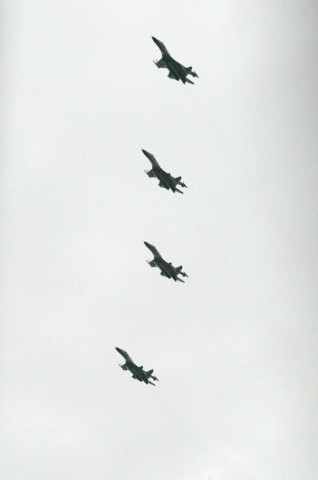US forces operating 'normally' in China air zone
US will not change its operations despite move by China to monitor aircraft in the newly declared air defence zone.

File photo of Chinese fighter jets. PHOTO: AFP
But the State Department said US commercial airlines should observe China's demand to be given notice of aircraft entering the zone, while stating that compliance "does not indicate US government acceptance of China's requirements".
China flew warplanes into its air defence identification zone (ADIZ) on Friday, Chinese state media said, nearly a week after it announced the zone, which covers islands at the centre of a dispute between Beijing and Tokyo, raising regional tensions.
The Xinhua report indicated that Japan and the United States are continuing to disregard China's demands that aircraft submit flight plans when traversing the area in the East China Sea or face unspecified "defensive emergency measures".
"We have flights routinely transiting international airspace throughout the Pacific, including the area China is including in their ADIZ," Pentagon spokesman Colonel Steve Warren said on Friday.
"These flights are consistent with long-standing and well-known US freedom of navigation policies that are applied in many areas of operation around the world. I can confirm that the US has and will continue to operate in the area as normal."
Compliance by commercial flights "does not indicate US government acceptance of China's requirements for operating in the newly declared ADIZ," the State Department said in a statement.
Japanese airlines, under pressure from Tokyo, stopped following China's new rules on Wednesday, after initially complying.
Chinese air force spokesman Shen Jinke earlier said that several combat aircraft were scrambled to "verify the identities" of US and Japanese aircraft entering the air defence zone, according to Xinhua.
The Chinese planes, which included at least two fighter jets, identified two US surveillance aircraft and 10 Japanese aircraft including an F-15 warplane, Shen said.
Japan and South Korea both said Thursday they had disregarded the ADIZ, showing a united front after US B-52 bombers also entered the area.
Despite the scrambling of jets referred to in China's state media, Japanese Defence Minister Itsunori Onodera on Saturday said there were no "peculiar developments".
"We do not recognise there have been peculiar developments that we should disclose such as one where aircraft suddenly came close as the Chinese side announced yesterday," he said.
"We have been making our utmost efforts to be vigilant and we will continue," he added.
Beijing is facing considerable internal pressure to assert itself. China's state media called Friday for "timely countermeasures without hesitation" if Japan violates the zone but it shied away from threatening Washington.
Washington has security alliances with both Tokyo and Seoul, and analysts say that neither China nor Japan - the world's second and third-biggest economies, and major trading partners of each other - want to engage in armed conflict.
The Communist Party seeks to bolster its public support by tapping into deep-seated resentment of Japan for its brutal invasion of the country in the 1930s.
Such passions are easily ignited, and posters on Chinese social media networks have urged Beijing to act.
China's rules covering the zone require aircraft to provide their flight plan, declare their nationality and maintain two-way radio communication - or face unspecified "defensive emergency measures".
Both Japan, which denies that there is a dispute over the islands, and Washington have ADIZs of their own, and China accuses them of double standards - though China's zone includes a rock that is disputed between Beijing and Seoul, as well as islands controlled by Japan and claimed by China.
The European Union added its voice to the criticism of the zone, with its top foreign affairs official Catherine Ashton saying it "contributes to raising tensions in the region".
The Yomiuri Shimbun on Saturday reported that the United States and Japan will issue a joint statement demanding China scrap the air zone during a visit to Tokyo by US Vice President Joe Biden next week. Biden will meet Prime Minister Shinzo Abe on Tuesday.
The Philippines has voiced concern that China may extend control of air space over disputed areas of the South China Sea, where the two nations have a separate territorial dispute.



















COMMENTS
Comments are moderated and generally will be posted if they are on-topic and not abusive.
For more information, please see our Comments FAQ